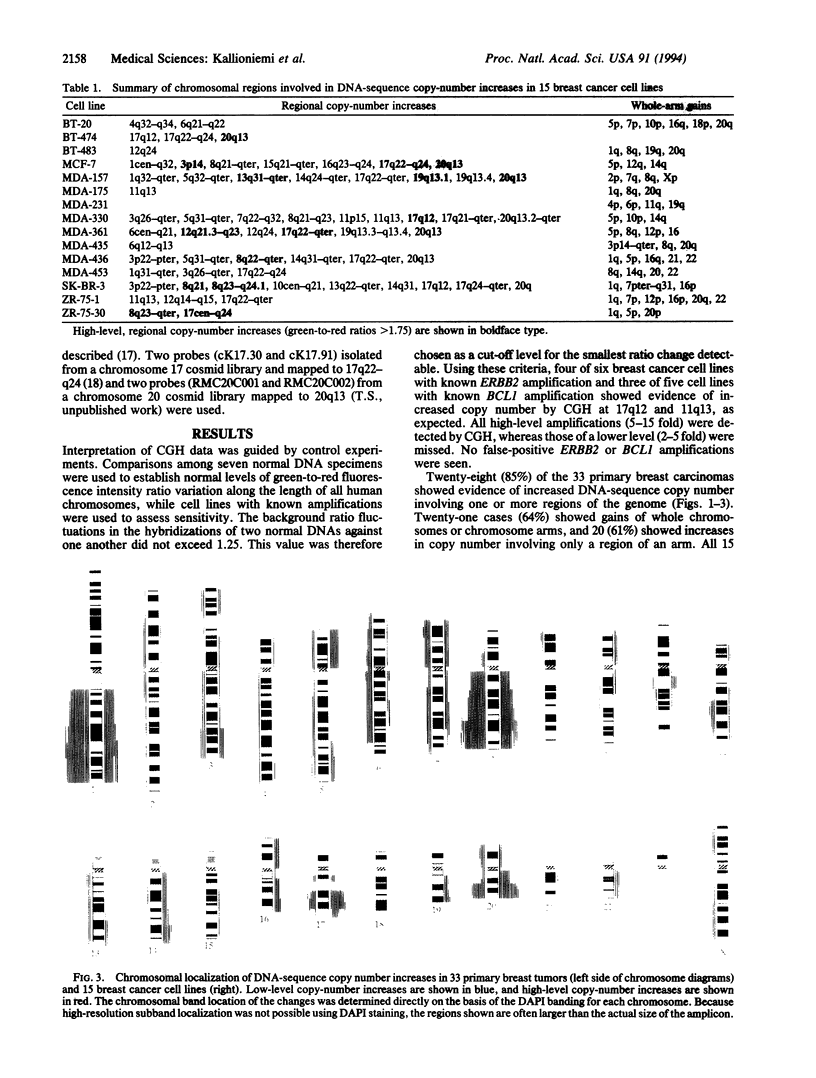Abstract
Comparative genomic hybridization was applied to 5 breast cancer cell lines and 33 primary tumors to discover and map regions of the genome with increased DNA-sequence copy-number. Two-thirds of primary tumors and almost all cell lines showed increased DNA-sequence copy-number affecting a total of 26 chromosomal subregions. Most of these loci were distinct from those of currently known amplified genes in breast cancer, with sequences originating from 17q22-q24 and 20q13 showing the highest frequency of amplification. The results indicate that these chromosomal regions may contain previously unknown genes whose increased expression contributes to breast cancer progression. Chromosomal regions with increased copy-number often spanned tens of Mb, suggesting involvement of more than one gene in each region.
Full text
PDF




Images in this article
Selected References
These references are in PubMed. This may not be the complete list of references from this article.
- Adnane J., Gaudray P., Dionne C. A., Crumley G., Jaye M., Schlessinger J., Jeanteur P., Birnbaum D., Theillet C. BEK and FLG, two receptors to members of the FGF family, are amplified in subsets of human breast cancers. Oncogene. 1991 Apr;6(4):659–663. [PubMed] [Google Scholar]
- Alitalo K., Schwab M. Oncogene amplification in tumor cells. Adv Cancer Res. 1986;47:235–281. doi: 10.1016/s0065-230x(08)60201-8. [DOI] [PubMed] [Google Scholar]
- Berns E. M., Klijn J. G., van Staveren I. L., Portengen H., Foekens J. A. Sporadic amplification of the insulin-like growth factor 1 receptor gene in human breast tumors. Cancer Res. 1992 Feb 15;52(4):1036–1039. [PubMed] [Google Scholar]
- Bishop J. M. Molecular themes in oncogenesis. Cell. 1991 Jan 25;64(2):235–248. doi: 10.1016/0092-8674(91)90636-d. [DOI] [PubMed] [Google Scholar]
- Dutrillaux B., Gerbault-Seureau M., Zafrani B. Characterization of chromosomal anomalies in human breast cancer. A comparison of 30 paradiploid cases with few chromosome changes. Cancer Genet Cytogenet. 1990 Oct 15;49(2):203–217. doi: 10.1016/0165-4608(90)90143-x. [DOI] [PubMed] [Google Scholar]
- Gebhart E., Brüderlein S., Tulusan A. H., von Maillot K., Birkmann J. Incidence of double minutes, cytogenetic equivalents of gene amplification, in human carcinoma cells. Int J Cancer. 1984 Sep 15;34(3):369–373. doi: 10.1002/ijc.2910340313. [DOI] [PubMed] [Google Scholar]
- Kallioniemi A., Kallioniemi O. P., Sudar D., Rutovitz D., Gray J. W., Waldman F., Pinkel D. Comparative genomic hybridization for molecular cytogenetic analysis of solid tumors. Science. 1992 Oct 30;258(5083):818–821. doi: 10.1126/science.1359641. [DOI] [PubMed] [Google Scholar]
- Kallioniemi O. P., Kallioniemi A., Kurisu W., Thor A., Chen L. C., Smith H. S., Waldman F. M., Pinkel D., Gray J. W. ERBB2 amplification in breast cancer analyzed by fluorescence in situ hybridization. Proc Natl Acad Sci U S A. 1992 Jun 15;89(12):5321–5325. doi: 10.1073/pnas.89.12.5321. [DOI] [PMC free article] [PubMed] [Google Scholar]
- Kallioniemi O. P., Kallioniemi A., Sudar D., Rutovitz D., Gray J. W., Waldman F., Pinkel D. Comparative genomic hybridization: a rapid new method for detecting and mapping DNA amplification in tumors. Semin Cancer Biol. 1993 Feb;4(1):41–46. [PubMed] [Google Scholar]
- Lammie G. A., Peters G. Chromosome 11q13 abnormalities in human cancer. Cancer Cells. 1991 Nov;3(11):413–420. [PubMed] [Google Scholar]
- Livingstone L. R., White A., Sprouse J., Livanos E., Jacks T., Tlsty T. D. Altered cell cycle arrest and gene amplification potential accompany loss of wild-type p53. Cell. 1992 Sep 18;70(6):923–935. doi: 10.1016/0092-8674(92)90243-6. [DOI] [PubMed] [Google Scholar]
- Machotka S. V., Garrett C. T., Schwartz A. M., Callahan R. Amplification of the proto-oncogenes int-2, c-erb B-2 and c-myc in human breast cancer. Clin Chim Acta. 1989 Oct 16;184(3):207–217. doi: 10.1016/0009-8981(89)90053-3. [DOI] [PubMed] [Google Scholar]
- Oliner J. D., Kinzler K. W., Meltzer P. S., George D. L., Vogelstein B. Amplification of a gene encoding a p53-associated protein in human sarcomas. Nature. 1992 Jul 2;358(6381):80–83. doi: 10.1038/358080a0. [DOI] [PubMed] [Google Scholar]
- Pandis N., Heim S., Bardi G., Idvall I., Mandahl N., Mitelman F. Whole-arm t(1;16) and i(1q) as sole anomalies identify gain of 1q as a primary chromosomal abnormality in breast cancer. Genes Chromosomes Cancer. 1992 Oct;5(3):235–238. doi: 10.1002/gcc.2870050310. [DOI] [PubMed] [Google Scholar]
- Saint-Ruf C., Gerbault-Seureau M., Viegas-Péquignot E., Zafrani B., Cassingena R., Dutrillaux B. Proto-oncogene amplification and homogeneously staining regions in human breast carcinomas. Genes Chromosomes Cancer. 1990 May;2(1):18–26. doi: 10.1002/gcc.2870020105. [DOI] [PubMed] [Google Scholar]
- Schwab M., Amler L. C. Amplification of cellular oncogenes: a predictor of clinical outcome in human cancer. Genes Chromosomes Cancer. 1990 Jan;1(3):181–193. doi: 10.1002/gcc.2870010302. [DOI] [PubMed] [Google Scholar]
- Slamon D. J., Clark G. M., Wong S. G., Levin W. J., Ullrich A., McGuire W. L. Human breast cancer: correlation of relapse and survival with amplification of the HER-2/neu oncogene. Science. 1987 Jan 9;235(4785):177–182. doi: 10.1126/science.3798106. [DOI] [PubMed] [Google Scholar]
- Smith K. A., Gorman P. A., Stark M. B., Groves R. P., Stark G. R. Distinctive chromosomal structures are formed very early in the amplification of CAD genes in Syrian hamster cells. Cell. 1990 Dec 21;63(6):1219–1227. doi: 10.1016/0092-8674(90)90417-d. [DOI] [PubMed] [Google Scholar]
- Smith S. H., Weiss S. W., Jankowski S. A., Coccia M. A., Meltzer P. S. SAS amplification in soft tissue sarcomas. Cancer Res. 1992 Jul 1;52(13):3746–3749. [PubMed] [Google Scholar]
- Yin Y., Tainsky M. A., Bischoff F. Z., Strong L. C., Wahl G. M. Wild-type p53 restores cell cycle control and inhibits gene amplification in cells with mutant p53 alleles. Cell. 1992 Sep 18;70(6):937–948. doi: 10.1016/0092-8674(92)90244-7. [DOI] [PubMed] [Google Scholar]
- Zafrani B., Gerbault-Seureau M., Mosseri V., Dutrillaux B. Cytogenetic study of breast cancer: clinicopathologic significance of homogeneously staining regions in 84 patients. Hum Pathol. 1992 May;23(5):542–547. doi: 10.1016/0046-8177(92)90131-l. [DOI] [PubMed] [Google Scholar]
- du Manoir S., Speicher M. R., Joos S., Schröck E., Popp S., Döhner H., Kovacs G., Robert-Nicoud M., Lichter P., Cremer T. Detection of complete and partial chromosome gains and losses by comparative genomic in situ hybridization. Hum Genet. 1993 Feb;90(6):590–610. doi: 10.1007/BF00202476. [DOI] [PubMed] [Google Scholar]





